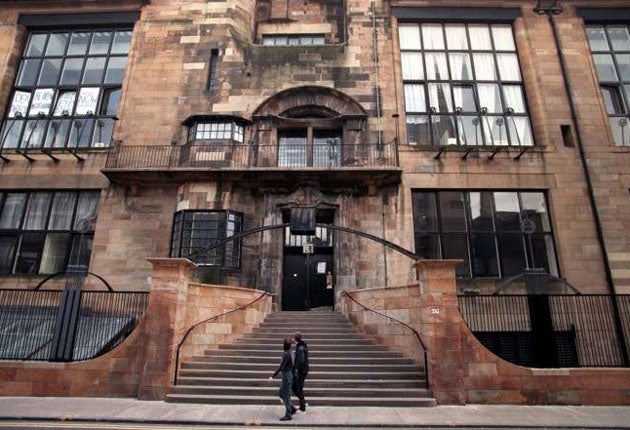Glasgow's big 'Mac' in architectural feeding frenzy
9,000 entries for £50m art school project

More than 9,000 architectural practices and design obsessives have expressed interest in creating a new students' building opposite the iconic Glasgow School of Art, a Grade I-listed building designed in 1898 by Charles Rennie Mackintosh.
The wave of enquiries – among them big-hitters like Lord Foster and Zaha Hadid – should generate about 1,000 bona fide competition entries, 600 more than for the London Millennium Bridge in 1997. The value of the "Mac" (as the school is known) project is a relatively modest £50m. The response was described as "extraordinary and unprecedented" by competition organiser, Malcolm Reading.
In a century awash with banal new buildings and unimaginative clients, it is the sheer challenge – and the risk of blatant architectural failure – that appear to have made the Mac project so irresistible.
Paul Finch, the ascerbic panjandrum of the World Architecture Festival, described the competition as an opportunity for architects to win a major cultural commission in Scotland untainted by either nationalist politics or royal interference.
He described the controversial Scottish Parliament building, designed by Catalan architects, as a "mini-republic of Scotland" response; and the Museum of Scotland as a project marked by "gross interference from the Prince of Wales, who was stopped in his tracks and struck down by the Marquis of Bute".
Mr Finch called the Mac competition "something without those connotations", adding: "It's without politics, and it's culturally enriched. It's irresistible. The iconoclasts, the Zahas and people of that ilk, won't win it because it calls for real intellectual weight and an enjoyment of masonry. This is a romantic and puritan project."
The Mac school's ability to inspire young architects and artists allows it to challenge ostensibly posher institutions such as the Royal College of Art and the Architectural Association, whose Bloomsbury façade carries an English Heritage blue plaque declaring, somewhat bumptiously: "Most famous architects 1847-2006 have been here (sooner or later)."
But not Charles Rennie Mackintosh, whose genius emerged after he enrolled as a modest evening student at Glasgow's original School of Art. Over 120 years later, the Mac's mystique remains founded on the riveting building designed by Mackintosh when he was not quite 30 and working for the Glasgow architects, Honeyman and Keppie.
Mackintosh's status as a cult figure is not confined to architecture. He was famed for his budget-busting over-attention to detail and, like Frank Lloyd Wright, he designed virtually every internal detail of a building, including furniture and fittings. The hanging lamps in the Mac's library resemble four mini New York skyscraper facades joined at the edges; the building's external iron railings are decorated with metal circles and stylised leaves derived from Japanese heraldry.
The Mac building's eclectic fusion of art nouveau, arts and crafts, geometrical elements and Scottish baronial features is unique. Mackintosh embedded them in a building with the tough urban manner of Glasgow's 18th and early 19th-century: sandstone facades, deeply "punched" windows and innovative heating and ventilation systems. On another's drawing board, such influences would have led to an architectural train-smash. But from the tip of Mackintosh's pen flowed pragmatic beauty; a building of gravitas and dazzling flights of decoration.
Today, with 1,900 students, the Mac surpasses the Royal College as Britain's second largest art and design school. One-quarter of the Turner Prize shortlisted artists since 2005 graduated from the Mac, including the 2005 winner Simon Starling. Other alumni have dominated Scotland's representation at the Venice Biennale since 2003.
The Barcelona-based architect David Mackay, who chairs the competition jury for the new building, said any design must be "challenged and motivated to reach the same coherence achieved by its [the Mac's] architect".
Kieran Long, editor of The Architects' Journal, noted that "the Mac has a very poor record of commissioning good architecture since the Mackintosh building. Everything else on the campus is pretty poor."
The deadline for submissions is tomorrow and a shortlist is expected mid-May. Paul Finch picked out Benson and Forsyth, Eric Parry, and David Chipperfield as potential shortlistees, but they will be in a tough shake-out with other practices including Hopkins Architects, redoubtable double-acts including John McAslan + Partners, and Nord, RMJM and Rafael Moneo.
"The jury's looking for something unusual," said Mr Reading. "They're nervous about building another Mac – a 21st-century version of it is not what they want. They want the next step. And it's also an urban design challenge. It's about designing an architectural touchstone for the next 100 years."
Join our commenting forum
Join thought-provoking conversations, follow other Independent readers and see their replies
Comments